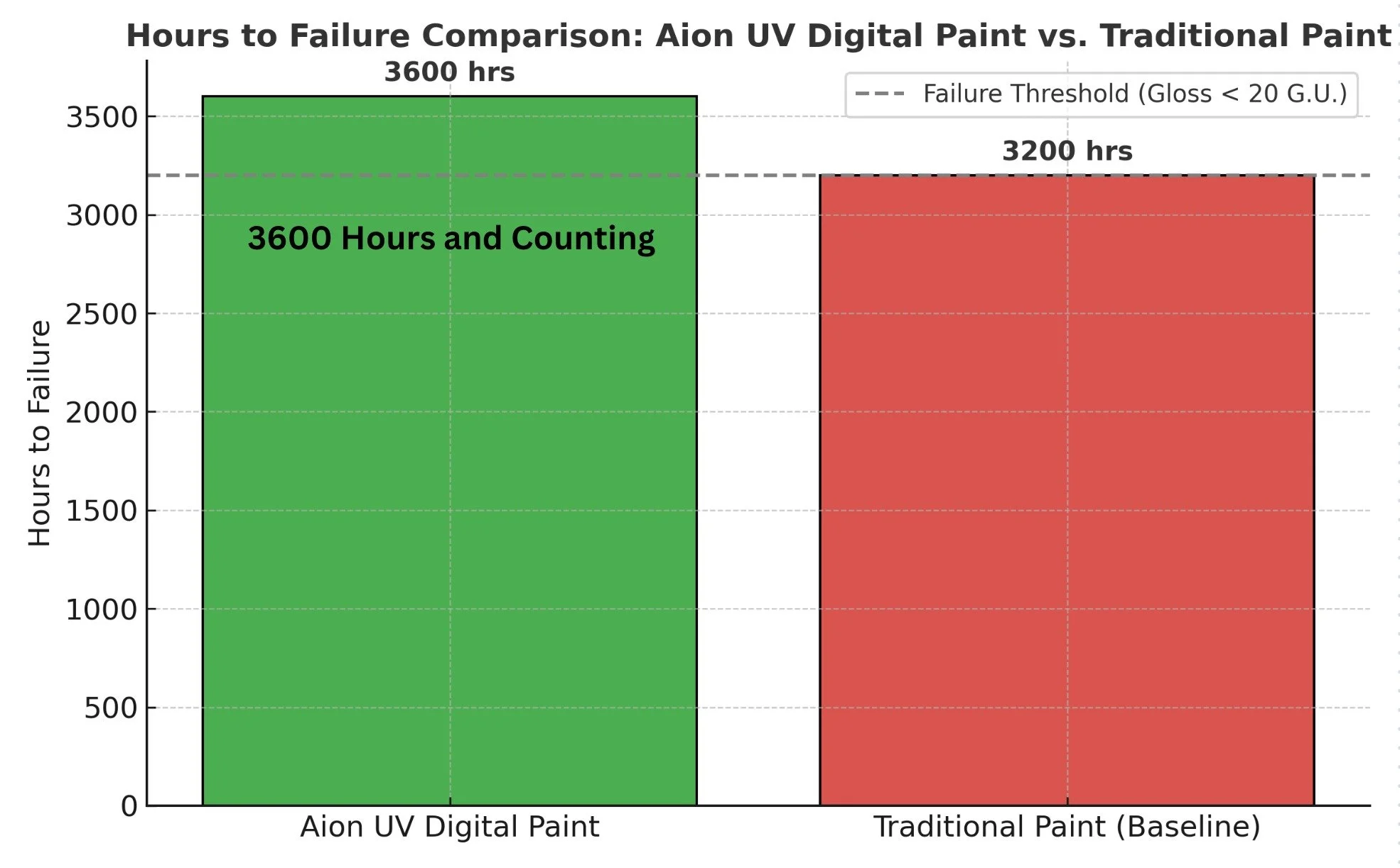
Testing
Xenon Arc Testing
ASTM G155 – Standard Practice for Operating Xenon Arc Light Apparatus for Exposure of Non-Metallic Materials
Aion UV’s proprietary digital paint technology was independently evaluated for ultraviolet and weathering durability.
Testing was conducted using a modified ASTM G155 Xenon Arc method, which simulates long-term exposure to sunlight, heat, and moisture on coated materials.
Test Method
The Xenon Arc test cycles ultraviolet light and water spray to replicate harsh outdoor environments.
Apparatus: Xenon Arc light chamber per ASTM G155
Cycle: 2-hour intervals
1 hour 42 minutes light
18 minutes light + water spray
Irradiance: 0.55 W/m²/nm @ 340 nm
Evaluation intervals: Every 200 hours
Measured properties: ΔE (color change CIELAB D65/10), 60° gloss retention, and adhesion/peeling
Failure criteria:
1. Color change > ΔE 2.0
2. Gloss < 20 G.U.
3. Loss of adhesion (peeling of printed layer)
Testing continued until any of these failure modes were observed for each specimen.
Conclusion
Under accelerated UV and moisture exposure, Aion UV Digital Paint maintained color stability, gloss, and adhesion for over 3,600 hours (and counting), surpassing traditional paint systems by roughly 400 hours and outperforming all other tested specimens.
These results demonstrate the exceptional longevity and fade resistance of Aion UV’s digitally applied coatings, providing OEM-level durability for RV and industrial applications with a precision finish and sustainable production process.
QUV (Quick Ultra Violet) Test
This tests for color change, Gloss Retention, Chalking, Cracking, Blistering, and Adhesion.
Time (Hours)
Length of QUV Testing
Aion UV digital paint chemically bonds with substrates, ensuring exceptional durability. Our most recent QUV test showed no visible changes after exposure 6 times longer than “standard” paint durability and 2 times longer than “exceptional” paint durability.
Note: Accelerated weathering tests, like QUV testing, simulate years of outdoor exposure in a short period. However, the hours spent in the test chamber do not directly translate to actual hours of product life in real-world conditions. Instead, these tests provide comparative data to predict long-term durability.
OEM Testing
Testing has been conducted by several OEMs including 2 of top 3 manufacturers
Adhesion test - Two surface scratch tests determine the adhesion level to the American Society for Testing and Materials standard.
Gloss test - Gloss meter used to determine gloss level before and after the weather chamber.
Hot/Cold test - Heat soak for seven hours followed by freezing overnight. This process is repeated in a three-day cycle.
Water test - Three-day water soak test for any flaking or damage to the surface. The water-soaked sample is transferred into a freezer overnight to review for cracking.
Chemical/Stain test - Tests for any permanent damage to the surface coating.
Pencil Hardness test - Two surface scratch tests determine scratch resistance and hardness level to the American Society for Testing and Materials standard.
Gravelometer - Tests for damage resistance to rock impacts.
Infrared Heat Cycling Delamination Test: This test evaluates the structural integrity and adhesion performance of digitally painted RV exterior wall systems when subject to rapid temperature fluctuations.




